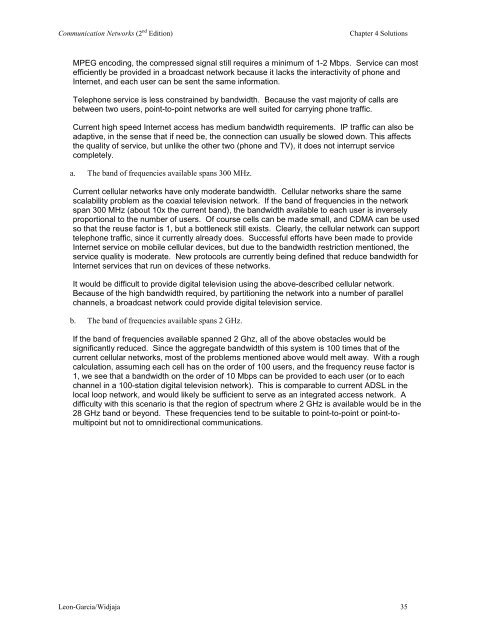Solutions to Chapter 4 - Communication Networks
Solutions to Chapter 4 - Communication Networks
Solutions to Chapter 4 - Communication Networks
Create successful ePaper yourself
Turn your PDF publications into a flip-book with our unique Google optimized e-Paper software.
<strong>Communication</strong> <strong>Networks</strong> (2 nd Edition)<br />
<strong>Chapter</strong> 4 <strong>Solutions</strong><br />
MPEG encoding, the compressed signal still requires a minimum of 1-2 Mbps. Service can most<br />
efficiently be provided in a broadcast network because it lacks the interactivity of phone and<br />
Internet, and each user can be sent the same information.<br />
Telephone service is less constrained by bandwidth. Because the vast majority of calls are<br />
between two users, point-<strong>to</strong>-point networks are well suited for carrying phone traffic.<br />
Current high speed Internet access has medium bandwidth requirements. IP traffic can also be<br />
adaptive, in the sense that if need be, the connection can usually be slowed down. This affects<br />
the quality of service, but unlike the other two (phone and TV), it does not interrupt service<br />
completely.<br />
a. The band of frequencies available spans 300 MHz.<br />
Current cellular networks have only moderate bandwidth. Cellular networks share the same<br />
scalability problem as the coaxial television network. If the band of frequencies in the network<br />
span 300 MHz (about 10x the current band), the bandwidth available <strong>to</strong> each user is inversely<br />
proportional <strong>to</strong> the number of users. Of course cells can be made small, and CDMA can be used<br />
so that the reuse fac<strong>to</strong>r is 1, but a bottleneck still exists. Clearly, the cellular network can support<br />
telephone traffic, since it currently already does. Successful efforts have been made <strong>to</strong> provide<br />
Internet service on mobile cellular devices, but due <strong>to</strong> the bandwidth restriction mentioned, the<br />
service quality is moderate. New pro<strong>to</strong>cols are currently being defined that reduce bandwidth for<br />
Internet services that run on devices of these networks.<br />
It would be difficult <strong>to</strong> provide digital television using the above-described cellular network.<br />
Because of the high bandwidth required, by partitioning the network in<strong>to</strong> a number of parallel<br />
channels, a broadcast network could provide digital television service.<br />
b. The band of frequencies available spans 2 GHz.<br />
If the band of frequencies available spanned 2 Ghz, all of the above obstacles would be<br />
significantly reduced. Since the aggregate bandwidth of this system is 100 times that of the<br />
current cellular networks, most of the problems mentioned above would melt away. With a rough<br />
calculation, assuming each cell has on the order of 100 users, and the frequency reuse fac<strong>to</strong>r is<br />
1, we see that a bandwidth on the order of 10 Mbps can be provided <strong>to</strong> each user (or <strong>to</strong> each<br />
channel in a 100-station digital television network). This is comparable <strong>to</strong> current ADSL in the<br />
local loop network, and would likely be sufficient <strong>to</strong> serve as an integrated access network. A<br />
difficulty with this scenario is that the region of spectrum where 2 GHz is available would be in the<br />
28 GHz band or beyond. These frequencies tend <strong>to</strong> be suitable <strong>to</strong> point-<strong>to</strong>-point or point-<strong>to</strong>multipoint<br />
but not <strong>to</strong> omnidirectional communications.<br />
Leon-Garcia/Widjaja 35







